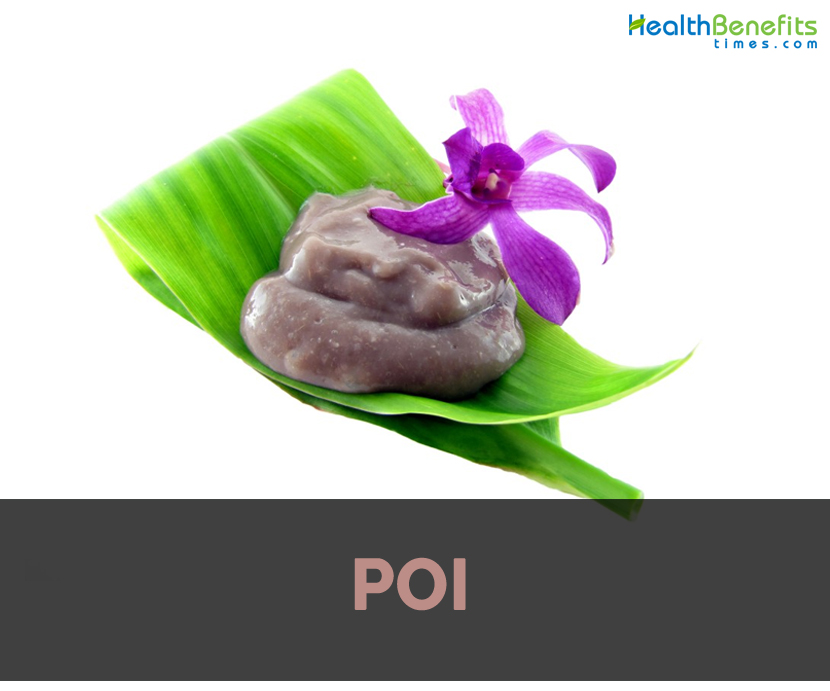Poi is also called one finger, two finger or three finger that depends on the consistency of poi implying how many fingers are required to scoop it in order to consume it. Poi has a mild and slightly sweet taste which pairs well with fresh island fish and often used as a dipping sauce.
Poi could be consumed fresh or left longer to ferment. Poi prepared from taro should not be confused with samoan poi, a creamy dessert formed by mashing ripe bananas with coconut cream and Tahitian po’e, a sweet pudding like dish which is made with papaya, bananas and mangoes cooked with coconut cream and manioc.
In Samoa and other Pacific islands, poi is a thick paste of crushed pineapples or bananas combined with coconut cream. The term stands for the action of crushed food to a pulp. People who cannot tolerate many foods could go for poi as the better option. In Hawaii, babies are fed poi as the first solid food. Poi is a starch with low fat, protein and contains several vitamins such as phosphorous, Vitamin B and calcium. Poi is hypoallergenic, gluten free and encloses heat and acid tolerant.
History and culture
Taro is a primitive ingredient highly rewarded by Hawaiians with a belief that taro plant was an original ancestor of Hawaiian people. It is a sacred aspect of Hawaiian life which is believed that spirit of Haloa (a legendary ancestor of Hawaiian people) persist when bowl of poi was kept uncovered for consumption.
Though many people in the world consume taro but only Hawaiians prepare poi. Traditionally, Hawaiians cook starchy taro root for hours in underground oven known as imu, also used to cook other types of food such as carrots, pork and sweet potatoes.
Recently, the shortage in production of taro led to increase in price for poi in Hawaii. Innovations in production of poi results in making poi fresh longer and also taste sweeter. Withal, such products sell at premium price and require refrigeration.
Culinary uses
- Mix the poi with milk and sugar.
- Serve poi with lomi salmon or salted fish.
- Sour poi is used as an ingredient in rolls and breads.
- Consume it for breakfast by adding it on rolls and bread or pair with fish.
References:
https://en.wikipedia.org/wiki/Poi_(food)
https://www.britannica.com/topic/poi-food
https://www.wonderopolis.org/wonder/what-is-poi
https://mauinow.com/2011/02/03/poi-a-brief-history-of-the-polynesian-staple-food/
Comments
| Poi Quick Facts | |
|---|---|
| Name: | Poi |
| Colors | Pale purple |
| Shapes | Paste |
| Taste | Sweet |
| Calories | 269 Kcal./cup |
| Major nutrients | Vitamin B6 (50.38%) Carbohydrate (50.27%) Copper (44.22%) Manganese (38.61%) Vitamin E (36.80%) |
| Name | Poi |
|---|---|
| Texture | Paste |
| Flavor | Delicate |
| Color | Pale purple |
| Taste | Sweet |
| Major Nutritions | Vitamin B6 (Pyridoxine) 0.655 mg (50.38%) Carbohydrate 65.35 g (50.27%) Copper, Cu 0.398 mg (44.22%) Manganese, Mn 0.888 mg (38.61%) Vitamin E (alpha-tocopherol) 5.52 mg (36.80%) Iron, Fe 2.11 mg (26.38%) Vitamin B1 (Thiamin) 0.312 mg (26.00%) Vitamin B3 (Niacin) 2.64 mg (16.50%) Vitamin B5 (Pantothenic acid) 0.703 mg (14.06%) Magnesium, Mg 58 mg (13.81%) |
| Calories in 1 cup (240 g) | 269 Kcal. |



